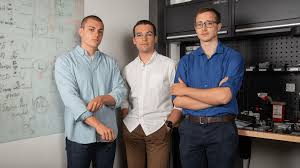
Arago, a French deep tech startup AI and computer hardware company blending electronics, photonics, and optics, has just secured $26 million in oversubscribed seed funding. The seed round was held to facilitate their mission to build photonic AI chips for data centers to reduce energy consumption.
The funding round held on July 8 was co-led by Earlybird, Protagonist, and Visionaries Tomorrow. They also had major support from Generative IQ, C4 Ventures, and renowned angel investors like Bertrand Serlet (ex-Apple VP and co-founder of Fungible), Christophe Frey (MD at Arm, France), Thomas Wolf (CSO of Hugging Face), Olivier Pomel (CEO of Datadog), and Jack Abraham (CEO of Atomic).
The Dawn of Light-Powered AI: What are Photonic AI Chips?
So, what exactly are photonic AI chips, and why are they such a game-changer?
Traditionally, computer chips rely on electrons to process information; however, photonic chips make use of “photons,” which are able to function in the same capacity through optical waveguides (microscopic pathways) etched on silicon or other polymers to guide the photons.
To work, photonic chips make use of a laser source to generate light signals, modulators to encode data onto the light signals, waveguides to direct the light signals around the chip, detectors to convert the light signals into electrical signals at the output, and interferometers to perform calculations by causing light waves to interfere with each other.
Photonic AI chips are specifically designed and optimized to accelerate the computations required for AI tasks, such as neural network training, AI inference, and machine learning algorithms.
They are considered a game-changer for AI and computing because they fundamentally address significant limitations of traditional chips like GPUs and CPUs in an era of exploding AI demand. Here’s why photonic AI chips are so exceptional:
- They overcome high power consumption and heat generation through massive energy savings, as protons do not require as much energy as electrons to operate. This also implies reduced operational costs, denser computing, and sustainable AI.
- Its photons perform at the speed of light, which implies higher speeds for data transfer. This in turn facilitates faster AI training and real-time AI inference.
- Photonic chips can leverage different wavelengths of light to transmit multiple data streams simultaneously through the same optical guide without interference. This wavelength division multiplexing (WDM) enhances parallel processing on a single chip and higher bandwidth.
- Photonic chips can aid in-memory/near-memory computing by reducing the need to move data between separate processing and memory units, reducing latency and power consumption.
Arago AI’s Vision: Building the Next Generation of AI Hardware
The Startup Behind the Tech
Arago was co-founded in 2024 by CEO Nicolas Muller, CTO Eliott Sarrey, and CSO Ambroise Muller, all experts in photonics, electronics, software, math, and machine learning. Arago runs with a tight-knit 20-member team spread across France, North America, the UK, and Israel.
Nicolas Muller describes their mission: “To build a product that’s high-performing, usable, and easily integrated into the ecosystem from day one.” Their bold mission is already taking root, as they have produced “JEF,” a photonic AI chip capable of running industry-standard AI models.
Meet JEF: The Chip That Promises 10x Efficiency Gains
Arago’s first product, code-named “JEF,” is a photonic AI chip with a hybrid architecture. It is a multiprocessor” because it combines elements of analog and digital electronics with silicon photonics and free-space optics.
“You had pure optical technologies and different technologies that are based on free space optics. What we built is a technology that overcomes all of those challenges by only using optics at very specific places,” Nicolas Muller said to EE Times.
JEF’s hybrid nature gives it the best of both worlds, as it uses light for raw AI computation and traditional electronics as practical means for memory, control, and overall system integration.
Early tests show up to 10x lower energy consumption than top-shelf GPUs at comparable throughput, while staying fully compatible with mainstream frameworks like PyTorch and TensorFlow.
The Bigger Picture: Lighting the Way for AI Hardware
Arago’s mission for photonic computing is a solution for energy-lean AI. If JEF lives up to its energy reduction and compatibility claims, this could unlock sustainable scaling of AI, lessen dependence on Nvidia’s GPUs, and pressure the industry to rethink how computing infrastructure evolves.
Earlybird co-founder Hendrik Brandis had this to say, “Arago is creating a ‘DeepSeek moment’ for AI chips. This technology has the potential to defy the laws of AI compute, using only a fraction of the resources. The Arago team is executing towards this moment with unseen velocity and frugality.”